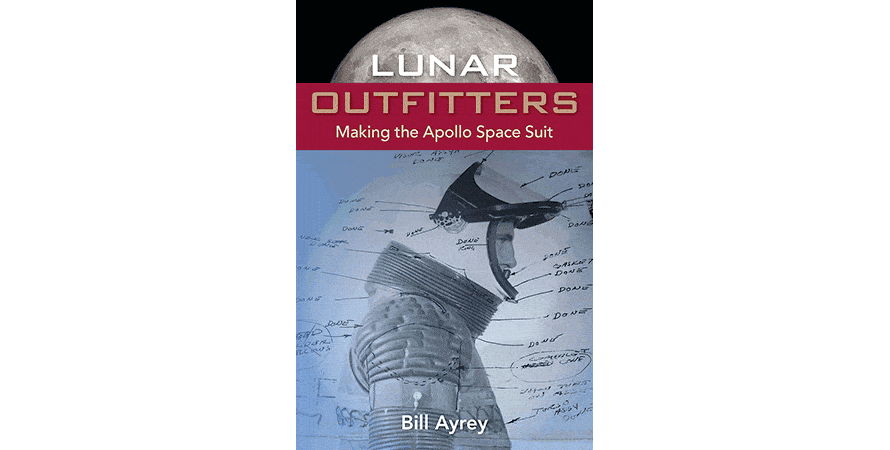Category: Non-Fiction
Reviewed by: Mark Lardas
Title: Lunar Outfitters: Making the Apollo Spacesuit
Author: Bill Ayrey
NSS Amazon link for this book
Format: Hardcover/Kindle
Pages: 648
Publisher: University Press of Florida
Date: October 2020
Retail Price: $35.00/$30.99
ISBN: 978-0813066578
The most iconic images of man’s presence on the Moon are photographs of astronauts standing on the Moon’s surface in distinctive Apollo-era spacesuits. The white suits were miniature spacecraft, offering life support while providing both the mobility and the flexibility to explore the Moon thoroughly.
Lunar Outfitters: Making the Apollo Spacesuit, by Bill Ayrey tells the history of their design, development and manufacture. The story Ayrey tells is archetypally American yet sometimes seems so improbable had it been fiction an editor would have rejected it. That is part of the fun of reading this book.
ILC – International Latex Corporation – designed and built the Apollo spacesuit. It was not an aerospace company before entering the spacesuit business. It started in the 1930s manufacturing latex consumer products, things like shower caps. Its best-known division is Playtex. During World War II they manufactured rafts and collapsible canteens. After that war, long before space travel and much less manned spaceflight, management became fascinated with the idea of building a spacesuit. They anticipated the demand, spending corporate money developing spacesuits throughout the early 1950s.
They were not rocket scientists. When they started they did not understand configuration management or systems engineering. As Ayrey shows, neither the owner nor most of the development team even had college degrees. What they had was an intimate knowledge of producing soft goods, ingenuity and perseverance.
Ayrey charts the course ILC followed to break into the spacesuit business and eventually win the contract to build the spacesuits used in the Apollo program. They were used inside the capsule, on the Moon’s surface and for extravehicular spacewalks during Apollo, Skylab, and ASTP. He shows the challenges ILC faced and the difficulties they overcame.
He follows the story from the company’s 1930s beginnings through the end of involvement with Apollo hardware. He concludes with ILC’s parking lot sale of much of its remaining hardware in March 1975. He closes with a discussion of the conservation, preservation, and restoration of spacesuit artifacts.
For those who want more, Ayrey closes Lunar Outfitters with four appendices. The first details technical specifications of an Apollo spacesuit. It provides almost enough information to allow a reader to build one. Other appendices list the serial numbers associated with the spacesuits and their parts, contract information associated with the Apollo spacesuits and the code names used to keep crew identities a secret when building the suits.
Ayrey might be the perfect person to tell the story. He joined ILC in 1977 as a temporary job to earn money to pay for an advanced degree. He moved into ILC’s test laboratory, which developed spacesuits, and stayed, eventually rising to manage the laboratory. Along the way he became entranced with the spacesuit history and became ILC’s unofficial spacesuit historian.
Lunar Outfitters is a rare and rewarding book. Ayres goes into the complexity of both spacesuit design and quality management in straightforward language. He provides copious illustrations. Without stinting on detail he explains things in language those without an engineering background can easily understand. Along the way he tells a story that is engaging and entertaining.
© 2021 Mark Lardas
Please use the NSS Amazon Link for all your book and other purchases. It helps NSS and does not cost you a cent! Bookmark this link for ALL your Amazon shopping!




















3 thoughts on “Book Review: Lunar Outfitters”
It’s been a long time since I’ve read a book cover-to-cover (well, OK, not the appendices) in a single sitting. I thoroughly enjoyed it and it will put me on the path of seeking out some of the other published works on space suits.
The problem with spacesuit design is NASA can not think outside the box. For instance in a space suit for a space walk, why function does it serve to have two legs? Or is a space walk in zero gravity really something you need to walk in? Even the best designs today are awkward, clumsy, and take extensive time to get in and out of. I would purpose a more useful design would be a small hard shell egg capsule the astronaut can jump into, seal, and go in a matter of minutes. Entirely self contained and somewhat like the pod used in the movie 2001, but much smaller and compact. The pod could also have snap on attachments for either jetting about space or tractoring on the moon. Arms could be replaced with robo arms, and these could also be teleoperated from Earth to help in some tasks. When not in use the unit would plug in and get recharged for fuel, air and battery charge and would be reset to go again in a matter of an hour.
I’m not a massive fan of those kinds, admittedly because of nothing more than aesthetic reasons; it’s undeniable that such suits would be far better on the ISS though. The point at which I disagree with you is that I don’t think NASA is at fault for this failure. The real problem is that the current suit design was designed in the *70s*, as NASA hasn’t had any appreciable budget for EVA suit replacements, and hence haven’t been able to build better spacesuits (even without considering that there hasn’t been a pure hardsuit in space *ever*).
While NASA is building the ‘new’ xEMU, it is in reality just an upgraded and modernised EMU, since they need suits cheaply and quickly for the Artemis Program. The next clean-sheet design will probably be from either SpaceX (for their missions) or China (who lack any spacesuit experience besides purchasing Russian Orlans).
So, while the suit design you propose will probably emerge at some point, it’s gonna be a while yet.